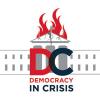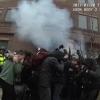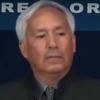Enough With the 'Alt' Already
Democracy in Crisis

Photo Credit: Andrew Kleindolph
It’s a bad time to have any kind of identification with the prefix “alt.” Richard Spencer and other Nazi-types started using “alt-right” in 2010 to refer to their racist, misogynist bullshit. Instead of ignoring their hate, it became apotheosized in the election of Donald Trump, and we were subjected to endless features about Spencer and the alt-right.
Now there’s been a spate of stories talking about the “alt-left” and even the “alt-center.”
Though some right-wing trolls have been trying to use “alt-left” as an online insult for a while now, it was James Wolcott’s Vanity Fair story “Why the Alt-Left is a Problem, Too” that made the term stick.
Wolcott’s piece lumped a wide variety of Twitter-types as “alt left” in a way that felt somewhat refreshing—who hasn’t been super-annoyed by Michael Tracy and recently Glenn Greenwald being hyper-skeptical about Russia but almost nothing else?
But it was also annoying. Democracy in Crisis runs in a number of papers that have been called “alt-weeklies” or the “alternative press” for decades. I was the arts editor and then managing editor (and now editor at large) at the Baltimore City Paper, an alt that was founded in 1977.
Wolcott knows all of this. A great writer, he got his start when he left Baltimore in 1972—the year I was born—to try to turn a letter from Norman Mailer into a job. When the Voice finally hired Wolcott—he just hung around the office for a long time—he did a lot to invent the kind of cultural criticism that would come to define alts.
So I was interested if he thought about that history as he wrote this piece for the far-slicker pages of Vanity Fair. I wrote him on Twitter and then tracked down his address and sent him a couple emails. Eventually, he responded to my questions.
"’Alt’ is shorthand for alternative, and has become a euphemistic prefix—’alt-right’ sounds a lot more innocuous than a white supremacist misogynist dudebro movement, and takes up way less space and breath. The ‘alt-left’ is more of a hodge-podge of die-hard socialists, embittered Berniebros, Occupy nostalgists, and grad-school Guevaras. What links them is a loathing of liberals in general, Hillary in particular, and a mystic dread of the Deep State.”
There is a lot to unpack in that and I’ll come back to it in a minute. But I was curious if he saw any connection between what he and Mailer did at the Voice with his use of “alt” in this piece. Like, one of the reasons people started papers like that was a sort of hatred of the liberal establishment.
“Mailer was keeping his hand in and blowing off steam in his White Negro phase and I was writing about pop culture, which I had grown up and Mailer hadn't,” Wolcott responded.
Ok, so I wasn’t gonna get anywhere with that.
I should say I also tried to contact Richard Spencer numerous times. I told him I did not subscribe to the view of journalism that required me to hide my feelings and I would be honest and tell him I despise everything he stands for and he will despise me. But I also had to admit he had taken this prefix that I’d had some attachment to and highjacked, if not destroyed, it.
But he didn’t respond. Still, in what I got from Wolcott, there is something that illuminates the alt-right as well. When he defines the alt-left through an aversion to the establishment liberals and the “Deep State” he hits on the thing that defines “alt” at the moment. And it fits in with the thinking of Aleksander Dugin, the arch-nationalist, ultra-right philosopher sometimes called “Putin’s Rasputin”—think Bannon with a beard, if Bannon actually wrote books.
In the “Fourth Ideology,” Dugin argues that liberalism is the first political theory of modernism. Communism was the second political theory and fascism the third. But once fascism and communism fell, liberalism changed, becoming not only one ideology but the only ideology, the “end of history” as Francis Fukuyama put it, postliberalism as Dugin has it, and neoliberalism to the rest of us.
“It is impossible to determine where the Right and the Left are located in relation to postliberalism," he writes. "There are only two positions: compliance (the centre) and dissent (the periphery).”
Dude is scary as hell, but that does offer a pretty good explanation of what is meant right now by “alt” whether on the right or the left (as well as the crossover between Bernie Bros and Trump Trolls).
And there, in this idea of dissent, we also have the “alt” of the alt-weeklies.
“Since our origin as the underground press, alt-weeklies have been just that—the dissidents that would feel right at home in the Island of Misfit Toys; the truth seekers that never treat a press release as gospel; and the story tellers that perpetually go against the grain and are never afraid to pull back the curtain and hold those pulling the strings accountable,” says Enrique Limon, editor of Salt Lake City Weekly.
But the fact that neither Wolcott nor Spencer or any of the other people talking about alts of any sort don’t acknowledge the existence of the alternative press is part of the problem—they are all still simply striving to be at the center, away from the periphery, as Wolcott did when he moved from Baltimore to New York.
After the election, pundits lamented the fact that reporters for the mainstream media are located in three or four cities and missed everything happening in what they allegedly term “flyover country.” Like these pundits, I too lament the death of the small daily. But I also acknowledge that those papers, like the mainstream media in general have a lot of fucking problems. We have always been an alternative to what is now dubbed the MSM (mainstream media).
I decided to write to some of my colleagues in the alternative press and see how they defined alt.
“As an alternative weekly, the Chicago Reader has always positioned itself as an antidote to the daily papers, one that questions the accepted narratives around all manner of issues, whether it be police shootings or public housing,” said editor Jake Malooley.
It’s not using “alternative facts,” like Kellyanne Conway, but rather digging up facts that the mainstream might ignore. Or thinking about them differently. “Topics the dailies don’t touch; takes and perspectives the dailies don’t have,” Kevin Allman, of New Orleans’ Gambit, replied.
Chris Faraone, of Dig Boston, writes alt media means “covering stuff that no one is covering and/or covering stuff correctly that other people are covering wrong.”
For Judy Davidoff, editor of Isthmus in Madison, WI, part of what others get wrong is in the very framing of the debate in terms competing opinions, “he said/ she said,” instead of looking for what is actually true. “If sources on either side of an issue offer two versions of events, we try to figure out what is true. So I think what we are seeing in mainstream media now — i.e. reporters calling out false statements as false—is something we've tried to do for a while.
Katherine Coplen, editor of Nuvo in Indianapolis, agrees. “For us, an alt-weekly represents an alternative way of annotating the status quo—the truest way, the shine-a-light way, the way that speaks truth to power,” she said.
“I often tell people being an alternative news journalist means I strive to report the truth – not ‘balance’ – with no concern about what might impact my economic and popularity status,” Mark Sabbatini, editor of Icepeople, wrote.
But James Allen of Random Length News, spells out the problem for the alts. We’ve always been going against the dailies and the cable news—now, since they are under attack by Trump, we are in the tricky position of defending them.
“It's hard to argue that the MSM doesn't have a bias in reporting, as we in the alternative press have maintained for decades, and now defend them as being the trusted purveyors of the real news,” he wrote.
For Matthew Steele, of Iowa City’s Little Village, it is a willingness to take a stand—and be transparent about it, that defines alt-media, which, he says, is “not just recording what's happening in our community, but actively working to change it— to move the moral center forward in accordance with the values we transparently espouse and advocate for.”
The transparency is important. Writers at alt-weeklies often reject the “view from nowhere,” instead choosing to connect with their cities. When Baltimore City Paper was bought by the daily a couple years ago, I noted: “An alt-weekly has a staff of paid reporters and editors whose jobs are not only to know the city, but to love it, to hate it, and to be an integral part of it, cajoling, ridiculing, praising and skewering city officials, artists and entrepreneurs alike.”
Perhaps we need to take the formula of these papers—there are more than 100 in the Association of Alternative Newsmedia—and apply it not just to the city, but to the country.
If we're really looking for an alternative to the mainstream media, we’d do a hell of a lot better if we listened more to alt-weekly reporters and less to people like Richard Spencer and even James Wolcott.
Keywords
More by Baynard Woods
-

With Much Love and Grim Solidarity, Democracy in Crisis Says Goodbye
Democracy in Crisis
-

Trump Uses the Legal System for His Own Ends
Democracy in Crisis
-

A Mexican Reporter's Death Threats Are the Future of Journalism in America
Democracy in Crisis









comments